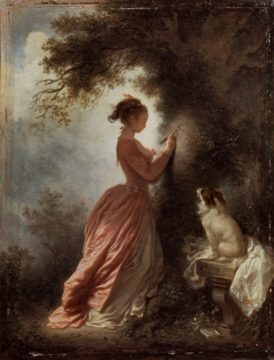Devika Girish at The Nation:
 When does a life become a story, a narrative legible to those outside it? This question trills at the heart of Joanna Hogg’s The Souvenir (2019) and the new The Souvenir Part II, a two-part film à clef constructed like a precarious house of cards: memories, texts, and ephemera from a life, stacked carefully one upon another in the hope that they hold their shape. The films take their names from Jean-Honoré Fragonard’s rococo 18th-century painting The Souvenir, which shows a woman in a lustrous pink gown carving an initial into a tree; a letter, presumably from her lover, lies on the ground by her feet. It’s an image of willful alchemy—of turning a memory, a feeling, into an object and event in the exterior world. The painting itself reifies a scene in Jean-Jacques Rousseau’s epistolary 1761 novel Julie; or, The New Heloise, about the mercurial passions between a married woman and her former flame—which in turn draws on the medieval tale of the French nun Héloïse d’Argenteuil and, likely, Rousseau’s own romantic entanglements. To this series of artistic transfigurations, Hogg adds her own, constellating personal references as she reconstructs her youth: the 1938 song “A Souvenir of Love” by Jessie Matthews, the films of Powell and Pressburger, period fashion from Manolo Blahnik and Yohji Yamamoto, letters from Hogg’s former lover, 16-millimeter pictures she took in the 1980s. Together, all these objects and invocations comprise a life of the mind, an intellectual history assembled in the hope that it might represent something more than just that: the haphazard accumulations of one’s time on earth.
When does a life become a story, a narrative legible to those outside it? This question trills at the heart of Joanna Hogg’s The Souvenir (2019) and the new The Souvenir Part II, a two-part film à clef constructed like a precarious house of cards: memories, texts, and ephemera from a life, stacked carefully one upon another in the hope that they hold their shape. The films take their names from Jean-Honoré Fragonard’s rococo 18th-century painting The Souvenir, which shows a woman in a lustrous pink gown carving an initial into a tree; a letter, presumably from her lover, lies on the ground by her feet. It’s an image of willful alchemy—of turning a memory, a feeling, into an object and event in the exterior world. The painting itself reifies a scene in Jean-Jacques Rousseau’s epistolary 1761 novel Julie; or, The New Heloise, about the mercurial passions between a married woman and her former flame—which in turn draws on the medieval tale of the French nun Héloïse d’Argenteuil and, likely, Rousseau’s own romantic entanglements. To this series of artistic transfigurations, Hogg adds her own, constellating personal references as she reconstructs her youth: the 1938 song “A Souvenir of Love” by Jessie Matthews, the films of Powell and Pressburger, period fashion from Manolo Blahnik and Yohji Yamamoto, letters from Hogg’s former lover, 16-millimeter pictures she took in the 1980s. Together, all these objects and invocations comprise a life of the mind, an intellectual history assembled in the hope that it might represent something more than just that: the haphazard accumulations of one’s time on earth.
more here.
